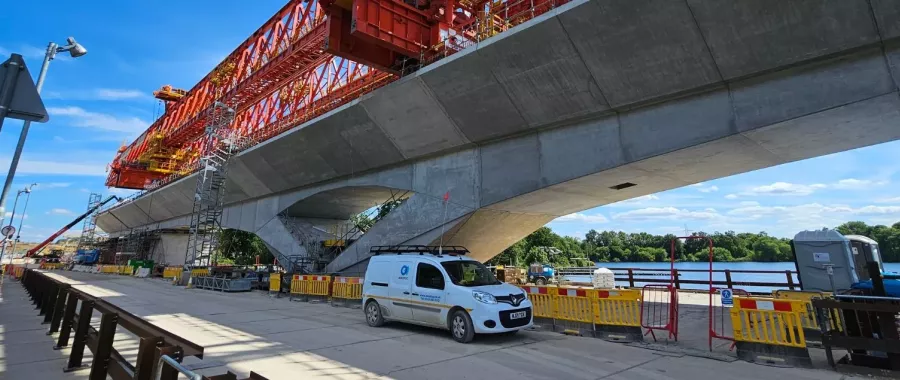Richard Hildick-Smith, director, SOCOTEC Monitoring UK, discusses how the team can best support clients with geotechnical and structural monitoring services.

Almost anyone can decide to monitor a parameter on their asset, buy a sensor off the shelf, install it (if they can get access to that area), then get the raw data from that sensor. However, this is not ‘Monitoring’. In order to get the benefit from a Monitoring system, the end-to-end process has multiple challenges and complexities.
System specification and design
- Really understanding the parameter(s) to be measured - this is not just specifically those parameter(s), but how they fit into the wider structural behaviour/activities. For example – what else needs monitoring in order to get an understanding?
- Work with the stakeholders (asset owners/operators, construction and demolition contractors) to understand why the monitoring is being undertaken.
- Support the clients engineering teams to design a fit-for-purpose system from the huge range of equipment suppliers. Most Monitoring systems require multiple sensor types and combining the best sensors into an integrated system is vital.
- Taking a system design and working a configuration and installation solution to make this happen is a huge challenge and requires significant experience in how systems can best be implemented.
- Do not ‘gold pate’ the sensors or solution. Sensors and systems vary hugely in their cost and complexity (e.g. materials, frequency and accuracy of measurement). Getting a system that fulfils the requirement at the best cost is key.
- Determine the alignment between manual and automated monitoring (including manual surveying).
- Sensor technology is constantly evolving. Working proactively and strategically with a range of sensor suppliers means the best selection of sensors.
- Ensure the system has appropriate redundancy of sensors/power/communications (especially if there are issues with future access and maintenance).
- If part of a new asset build – work with the designers from an early stage (e.g. embed sensors as part of construction).
Safe and quality install
- Getting the right location and placement of sensors is key. E.g. having the right bracketry for sensors. In many instances, these are completely bespoke to the requirement and the environment. Get the installation wrong and you can have the best-designed system with the most expensive sensors – and it will not give accurate data.
- Often where sensors are required are in difficult areas to access – tunnels, bridges, heights, confined spaces – ensuring the right competence, tickets, training, possessions and permits are imperative to keep everyone involved safe.
- The complexities around permits and access are often overlooked. This is where the experience, contacts and competence is vital. Having Project and Operational teams that can execute the base plan, but also work around changes and issues means that the cost and schedule can be maintained as close as possible.
- Flexibility in installation schedules is vital. Having a range of resources, supplemented by trusted sub-contract partners, allows flexibility and reactivity with site works (inevitably there are last-minute site schedule changes and constraints that need to be managed).
Quality data and insight – the vital part!
- Designing and installing the right system is pointless – until the stakeholders get their accurate data, report and alarms.
- Any project needs to have a close interaction with the stakeholders to understand and deliver a bespoke visualization specific to that Project. The views, graphs, plots and reports vary for every project – there is no quality ‘one size fits all’.
- Set-up the correct alarms (if necessary) so that the right people get informed in the appropriate time to alarm levels being exceeded.
- Offer data review services to validate the data for the client. Separating out genuine movement/change from issues, such as sensors being kicked/losing power.
- Ensure the users of data have been trained in accessing and using the data from the Software Platform.
- Post-processing of raw data. Most of the time, sensor data is integrated up and processed (algorithms, equations and integration with other sensors) to create ‘virtual sensors’ and other parameters that are needed to really understand the behaviour.
Maintenance and decommissioning
- Systems are often installed for years, and ensuring the quality of data is maintained throughout is vital. Having a perfect system for a week that then falls over is useless.
- Thinking about the technical elements required for ongoing maintenance (e.g. calibration and battery changes) is needed to enable this.
- It is important at the end of a project to decommission and remove all equipment to return the asset to their original condition.
It is not as simple as buying a sensor and installing it! This is where SOCOTEC Monitoring is able to support you in the end-to-end process. We have 30 years of experience of designing and installing monitoring systems in a huge range of environments. We have always been on the forefront of utilising the best technology and developing bespoke systems for clients. We are involved with and have won awards across a range of Civil, Infrastructure, Energy and Construction industries.
The goal is always to ensure clients get the right data so that they are able to better manage their activities and operations.
Monitoring as part of wider construction activities
Often Monitoring Projects come with additional related requirements such as: Materials Testing, Structural Investigation, Environmental testing and Ground Investigation. Within SOCOTEC UK there is the ability to cover all of these requirements and more. So, from a client’s perspective, there is a single interface that is able to deliver multiple scopes. There are huge benefits of this from a Technical and Commercial perspective.
Want to find out more about our Geotechnical and Structural Monitoring services?

You might also like







Add new comment